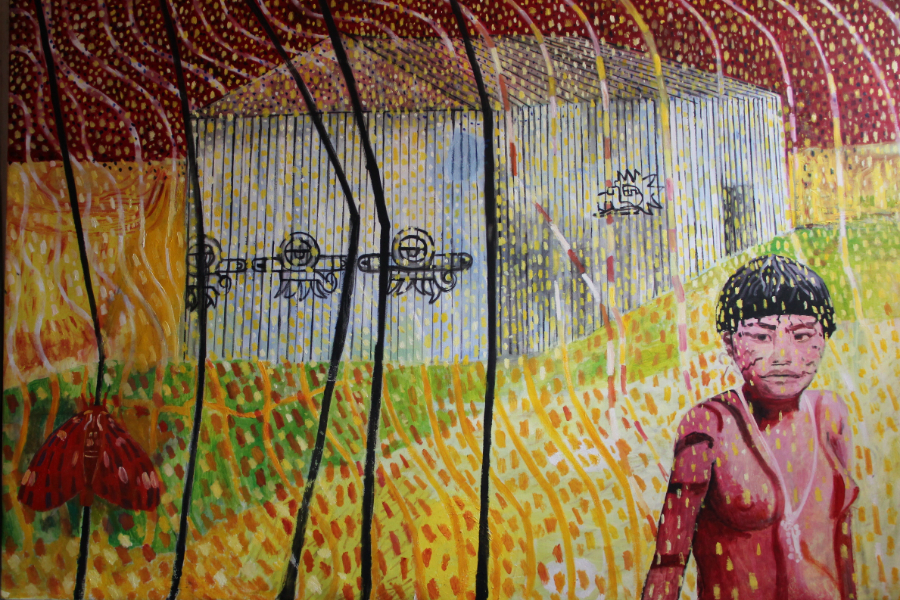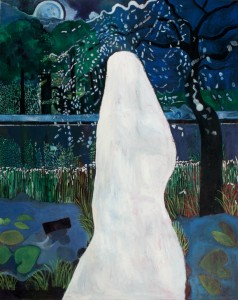Richard Creed: Spirit Body and Don Juan’s Hut

Kate Murray’s essay on painter Rick Creed reflects on two paintings that define the artist’s practice…
Walking into Richard Creed’s studio I find canvases… Creed’s studio is overflowing with canvases. The majority of the works are large in scale; paint pots and paint brushes fill each corner, as well as the odd teacup and pot of turpentine.
Creed discusses the multitude of influences that have impacted on his work. Many of which can be associated with his immediate surroundings: traditional painting, the internet, literature, photography, film and the everyday. For him, painting is a daily practice and he is passionate to convey a strong narrative in his work. Mark making, colour and subject matter create powerful images, which seem to almost exude sound through their vibrancy and awaken the senses.
Artists of course continue to be influenced by their predecessors: Paul Nash, Henri Rousseau and Picasso are amongst many of the British and International artists that have inspired Creed. On closer inspection one may also view the patterning and colour as comparable to the work of Gustav Klimt… beauty almost camouflaging the underlying meanings within the image, so often encapsulating terrifying conflicts between man and nature, and notions of good and evil.
Montage and collage are key processes in the early stages of composing a painting. He will place a combination of materials upon a smaller scale surface such as an A5 piece of card and construct the image he has in mind. This image is then transferred on to the canvas. These smaller scale compositions are art works in their own right, and reiterate the importance of artistic process both through thought and practice.
Similar to ideas considered by the German painter Kurt Schwitters with his Merz images, Creed is endeavouring to make a coherent aesthetic depiction of the world around him. His work could be conceived as political or non-political. The beauty of paintings is that they are open to interpretation. Viewers can take from the subject matter what they will in relation to their own lives and circumstances and this gives the paintings a clear accessible quality.
Spirit Body (2011) encapsulates the concern with human presence in the natural environment. A number of cross-cultural references are portrayed, reflecting contemporary British demographics: is this a ghost, a muslim, a catholic? Social contexts, which confront definitions of gender and culturally mixed identities, are explored.
Creed describes the overall theme as paradise lost: “the material world evaporates into a surrealistic physical or psychological dystopia.” Spirit Body suggests a range of iconic cultural references and identifies notions of the public and the private, encapsulated within the painterly conventions of the image.

Don Juans Hut (2012) is a painting based on the writings of author and anthropologist Carlos Castaneda, in which Castaneda refers to his alleged training in Shamanism under the guidance of the Yaqui Don Juan Matas. The painting is a platform for telling a story that relates to cultural myth whilst referencing Creed’s own adolescent memories.
Today, information on Castaneda and Don Juan can be instantly accessed online, unlike when Creed was growing up. He obtained information through books and newspaper articles, and became intrigued by the idea of Don Juan’s hut far away from the normality of everyday life.
He comments: “I was brought up with the front pages of the National Enquirer which gave the public popular surrealism at a cheap price and created the notion of conspiracy theory… Henri Rousseau asked questions about our relationship and understanding of the exotic in art and life, particularly how we experience the forest or jungle. As an urbanite my knowledge of the wilderness is second-hand and I’m intrigued about how to make paintings about it.”
Whether Castaneda’s writings are fictional or not is irrelevant to this painting. In the work Creed portrays a narrative, which the viewer can interpret how they wish: as fictional or non-fictional. For him the painting encapsulates his notion of the virtual in relation to his idea of travel. Technology has enabled us to consider the idea of travel differently. There has been a paradigm shift and thus, travel is no longer perceived as it once was.
The ideas behind his paintings stem from popular stories he heard as a child, and currently through sources such as immediate news coverage. Through themes dealing with alienation, Don Juan’s Hut presents the shifting paradigm approach to media and method and explores a combination of diverse visual conventions from historical painting to more contemporary everyday imagery.
This is identified through the Mayan symbols which can be seen on the outside of the hut, the hut itself a primary shape, with three dimensions and a flat surface (the basic composition of any form or structure), the use of colour and pattern, the poignant look in the eyes of the figure.
Creed says: “There are two strains of thought within the work: the first is ‘realising’ the imagery in trying to reconcile art historical issues in terms of modernist and post-modernist conventions, and the second is the combination of two different modes of perception, using traditional methodologies which are far more anonymous and detached.”
Creed’s own ideas of the exotic are portrayed as well as ideas relating to being a painter in 2013. Many of his paintings could then be described as contemporary Renaissance works, with the theme of storytelling through classical sources and myth.
In a recent lecture by Francesco Manacorda, Artistic Director of Tate Liverpool, the idea of the transfer of interpretive disciplines was discussed. One was left to contemplate how such disciplines could be applied into different modes in order to demonstrate further knowledge of the world. Manacorda discussed working towards exhibitions that address the swapping of stories and the exchange of ideas.
Such thinking is highly prevalent in Creed’s work and appropriate to considering the various ways in which art works can be accessed by the viewer. Creed’s work allows for different interpretations of subject matter, encapsulated into one simultaneous moment. These incongruous fragments establish a set of ideas for the viewer to further contemplate, presenting endless degrees of meaning.
Kate Murray
Richard Creed has exhibited internationally, including in Sweden, China and Singapore. Most recently he has contributed a film entitled Presence to the Memories exhibition for the 2011 Asia Triennial Manchester.
See Rick’s website rickcreed.wix.com





